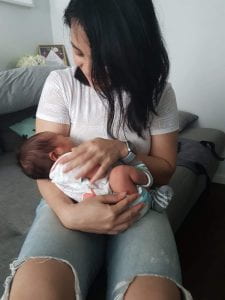Source: (Weisleder, A., & Fernald, A., 2013)
According to the article titled ‘How do Little Kids Learn Language’ published in Frontiers for Young Minds, children learn languages differently because of differences in their environments. For example, some children have more books than others and that may have an implication on their vocabulary size (assuming that their caregivers read to them more). In our lab, we often hear from parents who are anxious about their children’s development milestones regarding language development. Language development is a challenging field of study. Although some scientists disagree with one another on some theories, but they have a mutual understanding that language learning for a child takes time to build over a period of time.
One of the most commonly used methods for studying infants and toddlers is eye-tracking. The basis of an eye-tracking paradigm is that we look at something when we’re interested and look away when we’re bored. Studying the eye movements would assist scientists to understand what the child knows especially if they aren’t producing any words yet. To illustrate two images such as a ball and a cup are placed on a TV screen. The children are asked, “Do you see the ball?”. The speed and accuracy of the eye movement searching for the ball is measured by using a fancy eye-tracking camera. Our lab is currently designing some eye-tracking tasks for babies aged 0-6 months!
Another method is to ask with parents to identify the list of vocabulary the children are familiar with. This method is usually used for children below the age of three. They are provided with a long list of words and asked to check them off. However, asking parents to check off words may not be as effective as they may not be able to remember. In US and UK, these wordlists have been standardised and well-studied. Some parents and educators even use these lists to identify children at-risk for language disorders. In Singapore, these wordlists have yet to be standardised and norms are not yet established. Our lab is currently redesigning these wordlists to fit Singapore’s language landscape and will be asking for participants soon. Parents, you can sign up here if you are interested! Sometimes, researchers visit the homes of the children to investigate their language environments. A well-known study is the ‘Thirty Million Word Gap’, by Betty Hart and Todd Risley. They visited 42 homes monthly, recorded what the children, from ages 9 months to 3 years, spoke and heard for an hour. It was found that children who had a larger vocabulary were more frequently spoken to by their parents. Another significant finding was that children who heard more words came from financially stable families. A scientific graph was plotted to predict the vocabulary size as the children grew to indicate the number of new words they had learnt over time. Children with larger vocabulary sizes when they were young continued to have this advantage as they grow. However, this is a problematic finding. According to other researchers, the 30 million word gap seems exaggerated and results have not been replicable. Furthermore, there were confounding factors like an ‘observer effect’ as the researcher (white females) observed low-income black families. In recent years, to remove the ‘observer effect’ and for more accuracy, researchers have turned to smart recorders like the LENA device. Even then, in a much larger study with 329 American families, the word gap found was only close to 4 million by the time a child turns 4. In a multilingual environment like Singapore, combinations of various languages are spoken. We do not yet know anything about language environments of Singaporean children. In our upcoming Baby Talk-a-Thon study, we aim to recruit 500 families to do recordings of what their babies are hearing. The families will be handed the LENA device for non-invasive, fuss-free recording sessions. Interested to take part? Sign up here.
Read the original article ‘How Do Little Kids Learn Language?’ at
<https://kids.frontiersin.org/article/10.3389/frym.2017.00045>









